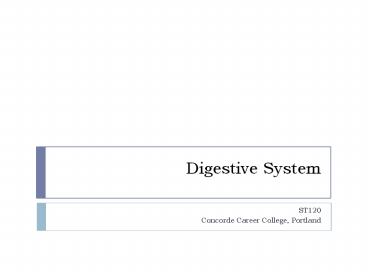Digestive System - PowerPoint PPT Presentation
1 / 59
Title:
Digestive System
Description:
Title: Digestive System Author: Doug Hughes Last modified by: Doug Hughes Created Date: 10/17/2004 6:41:00 AM Document presentation format: On-screen Show (4:3) – PowerPoint PPT presentation
Number of Views:153
Avg rating:3.0/5.0
Title: Digestive System
1
Digestive System
- ST120
- Concorde Career College, Portland
2
Digestive System
- Objectives
- Define the term digestion.
- Describe the functions of the digestive system.
3
Digestive System
- Objectives
- List and identify the structures of the digestive
system and describe the function of each. - List and identify the accessory structures of the
digestive system and describe the function of
each.
4
Digestive System
- Objectives
- Describe the importance of adequate nutrition.
- Describe the mechanism by which the digestive
system helps to maintain homeostasis.
5
Digestive System
- Objectives
- Describe common diseases, disorders, and
conditions of the digestive system including
signs and symptoms, diagnosis, and available
treatment options. - Demonstrate knowledge of medical terminology
related to the digestive system verbally and in
the written form.
6
Digestive System
- Digestion
- Mechanical, chemical, and enzymatic process by
which ingested food is converted into material
suitable for use at the cellular level.
7
Digestive System
- Functions of the Digestive System
- Digestion
- Absorption
- Note The digestive tract is also referred to as
the alimentary tract or canal.
8
Wall of the Digestive Tract
- From outermost to innermost
- Serosa (visceral peritoneum)
- Muscularis (2 layers)
- Submucosa
- Mucosa
9
(No Transcript)
10
(No Transcript)
11
Peritoneum
- Parietal - lines the abdominal cavity
- Visceral - covers the organs
12
Mesentery
- Fanlike peritoneal fold that is attached
posteriorly and attaches to the small intestine - Contains blood vessels, nerves, and lymphatic
structures
13
Mesocolon
- Fanlike peritoneal fold that is attached
posteriorly and attaches to the large intestine - Contains blood vessels, nerves, and lymphatic
structures
14
Diseased Mesocolon
15
Greater Omentum
- Flap-like peritoneal structure containing fat
that extends from the greater curvature of the
stomach to the pelvis
16
Torsion of the Greater Omentum
17
Lesser Omentum
- Extends between the lesser curvature of the
stomach and the liver
18
Digestive Organs
- Organs of the digestive tract (pathway)
- Accessory organs
19
Main Structures of the Digestive Tract
- Mouth
- Pharynx
- Esophagus
- Stomach
- Small Intestine
- Large Intestine
20
Oral Cavity
- Functions
- Ingestion
- Prepare ingested items for digestion
- Begin digestion of starch
21
(No Transcript)
22
Oral Cavity
23
Teeth
- Deciduous
- Permanent
- Structure
24
(No Transcript)
25
(No Transcript)
26
Mastication Deglutition
- Mastication
- Salivary glands
- Muscles
- Deglutition
- Muscles
27
(No Transcript)
28
Salivary Duct Stone
29
Pharynx and Esophagus
- Convey ingested items to the stomach
30
Deglutition
- Note movement of food bolus
31
Impacted Esophageal Food Bolus
32
Stomach
- Divisions
- Curvatures
- Sphincters
- Muscles
- Rugae
- Gastric Juices
- Chyme
33
(No Transcript)
34
Rugae
35
Gastrectomy Specimen
36
Stomach Interior
- Goblet Cells - Produce mucus
- Parietal Cells - Produce hydrochloric acid
- Chief Cells - Produce pepsin
37
Small Intestine
- Duodenum
- Jejunum
- Ileum
38
Villi
39
Large Intestine
- Cecum
- Ileocecal valve
- Vermiform appendix
- Ascending colon
- Transverse colon
- Descending colon
- Sigmoid colon
- Rectum
- Anus
40
(No Transcript)
41
Colectomy Specimen
42
Colectomy Specimen (Opened)
43
Rectum and Anus
- Rectum
- Valves of Houston
- Anus
- Anal columns
- Anal sinuses
- Anal valves
- Internal sphincter
- External sphincter
44
Accessory Structures
- Liver
- Gallbladder
- Pancreas
45
Liver
- Largest glandular organ in the body
- RUQ
- Two main lobes (right and left)
- Two small inferior lobes on the right
46
(No Transcript)
47
Gallbladder
- Located on the inferior surface of the liver
- Stores bile
48
Biliary Tree
49
Biliary Tree
50
(No Transcript)
51
Pancreas
- Endocrine gland
- Exocrine gland
- Extends from the duodenum (head) to the spleen
(tail)
52
(No Transcript)
53
(No Transcript)
54
Digestion
- Breakdown of foods into usable substances
55
Endoscopic Procedures
- Esophagogastroduodenoscopy visualization of the
esophagus, stomach, and duodenum - Colonoscopy visualization of the inner surface
of the entire colon from the rectum to the cecum. - Sigmoidoscopy visualization of the sigmoid colon
- Capsule endoscopy a tiny video camera in a
capsule that the pt. swallows. For 8 hrs it
passes through the small intestine and transmits
images of the walls of the small intestine.
56
Colonoscopy
57
Intestinal Disorders
- Diverticulosis the condition of having
diverticula - small pouch or sac occurring in the lining or
wall of a tubular organ such as the esophagus or
colon - Enteritis inflammation of the small intestine
caused by eating or drinking substances
contaminated with viral and bacterial pathogens - Gastroenteritis
- Irritable bowel syndrome (IBS) unknown cause
with symptoms that include cramping, abdominal
pain, bloating, constipation, and/or diarrhea.
58
Diverticular Disease
59
Some Procedures
- Gastrectmy
- Cholecystectomy
- Whipple pancreatectomy
- Diverticulectomy
- Ileectomy
- Jejunectomy
- Duodenectomy
- Colectomy
- Sigmoidectomy
- Proctectomy































